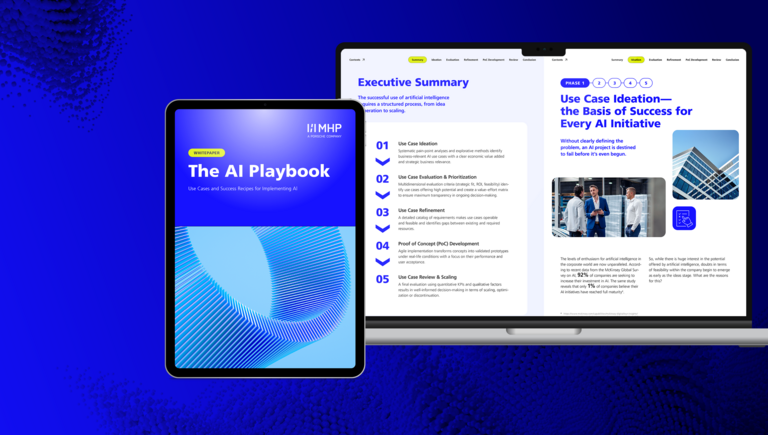
UX Maturity Report
How mature is the user experience of German companies?
How companies are developing UX from isolated initiatives into a scalable business lever.
Many companies invest in UX. But without structure, potential remains untapped.
Digital products and services are key to competitiveness today. However, in many organizations, UX is still seen as a “finishing touch” rather than a strategic lever. The MHP UX Maturity Report 2025 reveals the actual state of UX maturity in German companies.
Based on a cross-industry survey of specialists and managers, UX maturity was assessed using the MHP UX Maturity Model, ranging from a complete lack of UX to a strategic UX culture. The result: 46% of companies are stuck at level 3 (“partial UX integration”), with only 2% achieving a truly strategic UX culture.
At the same time, the study reveals significant gaps in resources and structures. For example, 49% rate their UX personnel resources as insufficient, 46% say they do not use a design system, while 95% are convinced that UX has a positive impact on the quality of their products.
The whitepaper combines this data with clear recommendations for action: It shows how roles, processes, and culture can turn individual UX initiatives into a resilient UX organization and how companies can systematically increase their UX maturity with a 6-step plan ranging from inventory to KPIs and pilot projects to broad competence building.
This provides decision-makers and UX managers with a practical roadmap for elevating UX from a project perspective to a corporate strategy—and thus measurably increasing customer satisfaction, efficiency, and innovative strength.
Key questions addressed in the white paper:
- How is the current level of UX maturity distributed among German companies: from “no UX structure” to a holistic, strategic UX culture?
- What does it mean in concrete terms when 46% of companies remain at level 3, and what risks arise from this “partial integration”?
- Why do 49% rate their human resources and 40% their financial UX resources as insufficient, and how can this be changed?
- What role do clear UX roles, career paths, and central responsibilities play in the field of UX?
- How can UX, product management, development, and leadership work together to build a UX organization that has an impact beyond individual projects?
- Why are design systems, KPIs, and systematic user research essential for higher UX maturity?
- What does MHP's 6-step plan look like, which companies can use to define their target maturity level, identify gaps, and grow in a targeted manner toward a strategic UX culture?